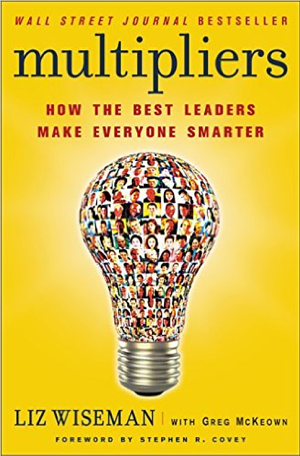In September 2010, a groundbreaking book emerged, challenging conventional leadership wisdom. This isn’t a book that’s complex or difficult to grasp; rather, it’s a mirror held up to every leader, compelling them to introspect: “Are you a Multiplier or a Diminisher?”

Authored by Liz Wiseman, former VP at Oracle University and now a leading consultant in the United States, in collaboration with British consultant Greg, this book is based on extensive research. Their findings lay the groundwork for a new, impactful Leadership Model.
Stephen Covey’s foreword in the book is particularly noteworthy. He praises it as a work that resonates with contemporary life and engages the reader’s conscience. True to his words, the book encourages profound self-reflection, challenging readers to evaluate their leadership style continually.
In today’s economic climate, where expanding teams isn’t always feasible, the book’s message is especially relevant. It aligns with Peter Drucker’s emphasis on enhancing the productivity of knowledge workers in the 21st century.
“Multipliers” provides practical strategies to double the effectiveness of your resources by transforming intelligent individuals into intelligence Multipliers.
The book introduces a leadership continuum, with Multipliers at one end and Diminishers at the other. The core assumptions of these two leadership types significantly influence their approach:
Understanding these foundational assumptions is vital, as behaviour naturally stems from them. One cannot think like a Diminisher and act like a Multiplier.
Wiseman identifies five disciplines of a Multiplier, contrasting them with Diminisher behaviours. The book methodically describes each, enriched with relatable examples. It suggests that regional cultural norms often push managers towards Diminisher tendencies, driven by fear and a desire to maintain control.
| Diminisher | Multiplier | |||
| The Empire Builder | Hoards resources and underutilises talent | The Talent Magnet | Attracts talented people and uses them at their highest point of contribution | |
| The Tyrant | Creates a tense environment that suppresses peoples thinking and capability | The Liberator | Creates an intense environment that requires people’s best thinking and work | |
| The Know-it-All | Gives directives that showcase how much they know | The Challenger | Defines an opportunity that causes people to stretch | |
| The Decision Maker | Makes centralised, abrupt decisions that confuse the organisation | The Debate Maker | Drives sound decisions through rigorous debate | |
| The Micro Manager | Drives results through their personal involvement | The Investor | Gives other people the ownership for results and invests in their success |
A key revelation is that Multipliers are not ‘feel-good’ managers. They are demanding yet achieve results by setting clear challenges for their team, demonstrating belief in their capabilities, and refraining from micromanagement.
The research underscores that Multipliers attract talent – people aspire to work for them. This is significant, as employee engagement surveys often point to management as a primary reason for staff turnover. The book posits that the real reason people leave is due to being managed by Diminishers.
If the book’s premise – that Multiplier Leaders can double staff capability – is accurate, it’s a strategy every organisation should consider.
The book’s strength lies in demonstrating the positive impact of common leadership competencies and providing tools for altering one’s leadership style. For example, becoming a better challenger involves shifting from answering to asking questions, a challenging yet enlightening approach.
Each Multiplier best practice is accompanied by clear, actionable examples for behavioural change. This book stands alongside leadership classics, relevant to the current economic climate and particularly applicable to the Middle East region.
A key revelation is that Multipliers are not ‘feel-good’ managers. They are demanding yet achieve results by setting clear challenges for their team, demonstrating belief in their capabilities, and refraining from micromanagement.
The research underscores that Multipliers attract talent – people aspire to work for them. This is significant, as employee engagement surveys often point to management as a primary reason for staff turnover. The book posits that the real reason people leave is due to being managed by Diminishers.
If the book’s premise – that Multiplier Leaders can double staff capability – is accurate, it’s a strategy every organisation should consider.
The book’s strength lies in demonstrating the positive impact of common leadership competencies and providing tools for altering one’s leadership style. For example, becoming a better challenger involves shifting from answering to asking questions, a challenging yet enlightening approach.
Each Multiplier best practice is accompanied by clear, actionable examples for behavioural change. This book stands alongside leadership classics, relevant to the current economic climate and particularly applicable to the Middle East region.
For business owners, CEOs, or leaders, this book is a must-read. Understanding whether you’re a Multiplier or a Diminisher, and how to evolve your approach to nurture others’ genius, is essential. The potential to double your team’s productivity could be transformative for both their worth and your business’s success. To delve deeper into these concepts and apply them in your organisation, explore the Multipliers Training Program offered by Biz Group. This program brings the principles of the book to life, providing practical tools and strategies for transformative leadership.
